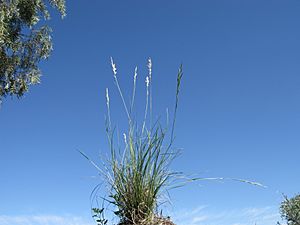Leafy wallaby grass facts for kids
Quick facts for kids Leafy wallaby grass |
|
|---|---|
 |
|
| Scientific classification | |
| Genus: |
Rytidosperma
|
| Species: |
bipartitum
|
| Synonyms | |
|
|
The Leafy Wallaby Grass (scientific name: Rytidosperma bipartitum) is a special type of grass. It's a perennial plant, which means it grows back year after year without needing to be replanted. You can find this grass growing naturally in the southeastern parts of Australia.
This grass often grows in places with heavier clay soils or rich, loamy soils. It loves to be in open areas, especially in eucalyptus woodlands, where the tall gum trees provide some shade but also plenty of sunlight. The Leafy Wallaby Grass usually grows in a clump, standing upright, and can reach a height of about 0.7 meters (which is almost as tall as a small person!).
Contents
What is Leafy Wallaby Grass?
Leafy Wallaby Grass is part of a group of grasses called "wallaby grasses." These grasses are very important to the Australian environment. They are known for growing in dense clumps, which helps them survive in different conditions.
Appearance and Growth
This grass has a unique look. It grows in a "tufted" way, meaning many stems grow closely together from a single base, forming a thick bunch. This makes it strong and able to withstand things like grazing animals or dry spells.
The leaves are, as the name suggests, quite leafy. They are usually green, but their exact look can change a bit depending on where they grow. The plant can stand tall and straight, making it easy to spot in its natural habitat.
Where Does it Grow?
Leafy Wallaby Grass is native to southeastern Australia. This includes several states, making it quite widespread in that region.
Habitat and Environment
You'll often find this grass in open woodlands. These are areas where trees like eucalyptus grow, but there's still plenty of space for sunlight to reach the ground. It prefers soils that are a bit heavier, like clay, or soils that are a mix of sand, silt, and clay, known as loamy soils. These types of soils are good at holding water, which is important for the grass to grow well.
Importance of Wallaby Grasses
Wallaby grasses, including the Leafy Wallaby Grass, play a big role in their ecosystems.
Food and Shelter
These grasses provide food for many native Australian animals, especially kangaroos and wallabies (which is how they got their common name!). They also offer shelter for smaller creatures like insects and lizards, helping to support the local wildlife.
Soil Health
Because they grow in clumps and have strong root systems, wallaby grasses help to keep the soil healthy. Their roots hold the soil together, preventing erosion from wind and rain. This is very important, especially in areas where the soil might otherwise be easily washed away.

